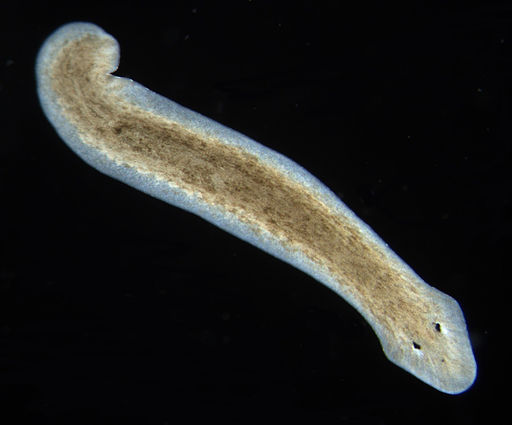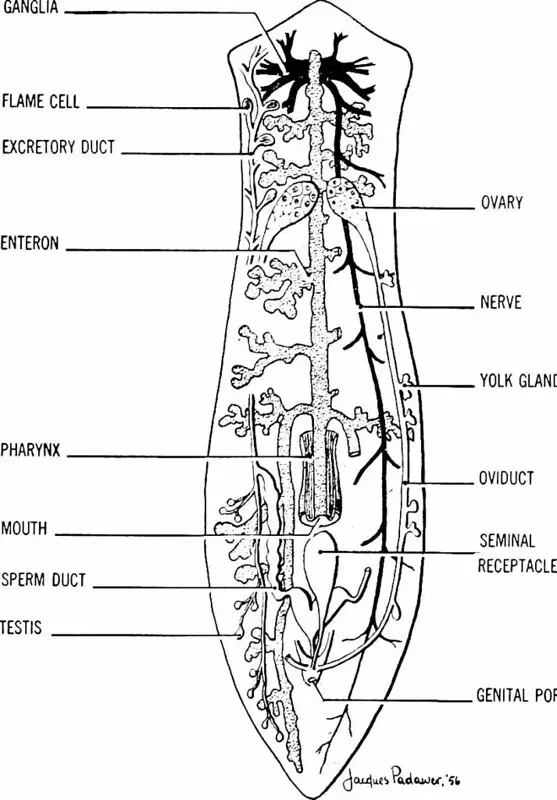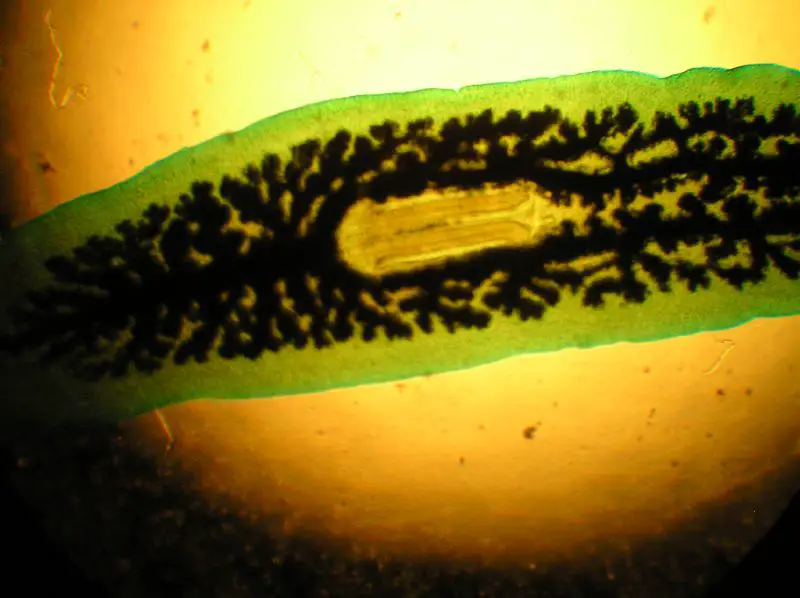Class Turbellaria
** Characteristics, Habitat, Reproduction and Life Cycle
Overview: Introduction to Turbellarians
With over 3000 members (species), Turbellaria is a class of the phylum Platyhelminthes. As such, they are multicellular flatworms characterized by flattened appearance. They can be found in many aquatic habitats as well as given terrestrial environments. For this reason, they are very common and easy to find.
For the most part, turbellarians (turbellarian worms) are free-living organisms in their natural environment. However, a few species exist as commensals or parasites in certain hosts (some marine fish and turtles, etc). They are also very colorful with different species exhibiting a variety of colors ranging from brown and black to blue and green etc.
Some organisms in the group have been shown to have a regenerative capability which has attracted significant attention from the scientific community.
* The class Turbellaria is the only group under the phylum Platyhelminthes that consists of free-living organisms - All the other classes are made up of parasitic species.
Some examples of species under the class Turbellaria include:
- Temnocephala lamothei
- Dugesia aenigma
- Dugesia bifida
- Planaria simplex
- Girardia dorotocephala
- Girardia tigrina
Taxonomy: Classification of Turbellaria
Kingdom: Animalia - As members of the Kingdom Animalia, members of the class Turbellaria are eukaryotic, multicellular organisms that are heterotrophic in nature. While some of the species are capable of asexual reproduction, these organisms also produce sexually.
Subkingdom/clade: Bilateria - Bilateria is a large group of organisms under the kingdom Animalia that are generally characterized by a bilateral symmetry - This means that if they are bisected (lengthwise) the left side of the body would be a mirror image of the right side.
Phylum: Platyhelminthes - Members of the class Turbellaria are classified under the phylum Platyhelminthes which consists of bilaterian, unsegmented invertebrates commonly known as flatworms. They are widely distributed in various environments across the world where they exist as free-living organisms or as parasites.
Class: Turbellaria - Characteristics of turbellarians are discussed below in detail.
The class Turbellaria is further divided into several orders that include:
- Catenulida
- Kalyptorhynchia
- Lecithoepitheliata
- Macrostomida
- Neorhabdocoela
- Polycladida
- Prolecithophora
- Proseriata
- Tricladida
Distribution/Ecology
According to some literature, the class Turbellaria consists of over 4,500 species. These species are widely distributed and can be found in just about all aquatic environments. While they are commonly found in both marine and freshwater environments, they have also been identified in various terrestrial habitats particularly in damp areas.
With a few exceptions (including such species as Varsoviella kozminski and Phaenocora beauchampi which are ectoparasites found in Europe), the majority of species found in free-living habitats are free-living organisms. As such, they feed on various organic matter and prey in their surroundings.
Other species found in parts of Australia and Europe live as commensals and depend on a number of organisms in their surrounding for survival (here, however, they do not cause harm to the host). Freshwater Turbellarians can be found in such habitats as lakes, ditches, water puddles, and ponds, etc.
Apart from the freshwater bodies mentioned, some of the species can be found living on leaves and soil among other surfaces. Here, however, they only survive in the presence of water films. In larger water bodies, diversity and the number of Turbellarian species are influenced by various environmental conditions.
In the Southern part of the United States, studies have shown the diversity of Turbellarians to be higher in the temperate climatic zone. These factors have also influence the distribution of given species, with some only being restricted to certain regions while others are widely distributed around the world (e.g. Macostomida).
While turbellarians can be found in freshwater and even terrestrial habitats, the majority of species live in marine habitats (oceans and sea) where they live as free-living organisms. However, some of the species exist as parasites or commensals.
Based on various research findings, the majority of these species (in marine environments) are smaller in size (most being less than 1mm in length). However, some, e.g. Polycladida, are significantly larger.
In this environment, turbellarians are commonly found in the aerobic zones of the sediment as well as littoral areas. While they can swim, they have been shown to adhere to grains in these regions and are also considered interstitial.
* Interstitial turbellarians can be found in the sand where they reside between grains of sand.
* Tricladida is exclusively terrestrial while larger species like Polycladida can be found under rocks and stones (they are described as being epibenthic).
Characteristics of Turbellarians
Morphology
The majority (about two-thirds) of turbellarians are small in size, measuring between 0.8 and 2mm in length. However, as already mentioned, a few species are larger in size and can grow to be several centimeters long.
Like many other members of the phylum Platyhelminthes, turbellarians have a dorsoventrally flattened body that is bilaterally symmetrical. The flattened body shape in these organisms is attributed to the fact that flatworms do not have a true body cavity, as such, they are known as acoelomates.
Apart from variations in size, members of this group also exhibit various differences in shape. While some of the species, e.g. Pseudobiceros bedfordi and Pseudoceros dimidiatus have a leaf-like shape (with pointed ends), others, like Planarians, have a ribbon-like appearance.
Others, like members of the genus Bipalium, also known as land planarians, are characterized by a slender, elongated body with a uniquely shaped head (thus the name hammerhead). Due to these differences, different groups under the Class Turbellaria can be identified based on shape.
Body Structure
Being multicellular organisms, turbellarians have a complex body structure that consists of a number of layers.
These include:
Epidermis
The epidermis of turbellarians is the outermost covering/layer that originates from the ectoderm. As the outermost layer, it's in direct contact with the environment (outer environment) and therefore acts as the protective layer of the organism. It's also in contact with the basement membrane which is located below the epidermis.
Based on earlier studies of this layer, four types of the epidermis were identified. These include the neoophoran epidermis (associated with neoophorans and with a well-developed basement membrane), the macrostomid epidermis (common in members of the order Macrostomida and Haplopharyngida where the basement membrane is lacking), the third type found in members of the orders Acoela and Nemertodermatida that lack the intercellular matrix and the fourth type found in Catenulida where the basement membrane is also absent.
Depending on the species, the epidermis may be ciliated while some are characterized by microvilli. The basement membrane is located below the epidermis and thus acts as a barrier between the epidermis and internal layers of the body wall.
* The epidermis is very thin and therefore must remain hydrated to prevent the worm from drying out - For this reason, turbellarians are commonly found in aquatic habitats.
Muscular Layers
Turbellarians have two sets of muscles below the basement membrane. These include the outer layer which consists of circular muscle and the inner layer that consists of longitudinal muscle. Apart from defining the general morphology of the organism, these muscles also play an important role in movement and changes in shape.
For instance, by contracting, the inner longitudinal muscles cause the worm to shorten which increases its diameter. Contraction of the outer circular muscles allows the organism to recover to the original shape/length. Through these actions, the organism can move in a worm-like manner.
Apart from these two layers of muscles, studies have shown these organisms to have an additional layer (diagonal muscle fibers). However, they are not involved in locomotion.
Parenchyma
The parenchyma consists of poorly organized cells which are located between the longitudinal muscle layer and gastrodermis (as such, they are among the cells that fill the body cavity). This region also consists of some cells of the epidermis (sunken gland cell bodies), stem cells as well as several types of the parenchyma which makes up the largest population.
Gastrodermis
The gastrodermis is the innermost layer. It originates from the endodermis and consists of one layer of cells that line the digestive tract. Some of the cells in this layer include epitheliomuscular cells and gland cells involved in the secretion of digestive enzymes as well as mucus. As such, this layer is involved in both the digestion and absorption of nutrients.
Feeding/Nutrition
In marine and freshwater habitats, where they exist as bottom dwellers, Turbellarians move by means of muscular undulations as well as by use of cilia which are located on the underside (ventral surface). In addition, they have also been shown to produce mucus which allows them to adhere to the substrate as they move about. The ability to effectively move about in their environment is particularly beneficial when it comes to feeding.
In aquatic habitats, Turbellarians are carnivores and therefore feed on small invertebrates in their surroundings. The ability to glide over surfaces/substrates using cilia and muscular undulations make it possible for them to hunt prey for food. Turbellarians are also scavengers and have to move around in search of dead animals in their surroundings.
As scavengers, they can feed on the remains of larger organisms. As parasites or commensals, Turbellarians attach themselves to fish and other organisms in their surrounding (as ectoparasites) and either feed on material on the surface of these organisms or on their tissue.
* Turbellarians also feed on bacteria and algae.
To feed, turbellarians use a mouth-like pore that is positioned at the pharyngeal cavity that is located at the ventral side of the organism. In Turbellarians, this is the only opening associated with the digestive tract.
Depending on the species, the mouth part of Turbellarians may be ciliated or consisting of a muscular complex organ. While feeding, the pharyngeal cavity extends allowing the worms to move food material into the simple digestive tract.
Digestion of food material has been shown to occur even before the food materials are ingested. Here, Pharyngeal glands produce enzymes that break them down into small portions. These portions are then ingested before they are engulfed by cells in the digestive cavity where they are further broken down (in food vacuoles) to complete the digestion process.
Given that turbellarians lack an anal opening, undigested food material are regurgitated and released through the mouth opening.
Nervous System and Sensory Organs
While Turbellarians have a simple nervous system, this may vary between different species. For Turbellarians with a more centralized nervous system (e.g. Planarians), it consists of a simple brain (ganglion), nerve cords as well as a sub-epidermal network of nerves. In these species, the simple brain is built from the thickened anterior part of the ventral cords and is located at the anterior/head region of the organism.
In some of the Turbellarians, however, the nervous system is more primitive and is known as the diffused nervous system. Compared to the central nervous system found in Planarians, this system consists of a subepidermal nerve plexus.
This system lacks a brain (ganglion) region that normally consists of a large concentration of nerves. As such, it simply consists of nerves that are distributed within the organisms. Because of its simple nature, this system does not allow for a prolonged or coordinated response.
In addition to the nervous system, turbellarians also have a few sensory organs that allow them to appropriately respond to their environment. For instance, they are equipped with chemoreceptors that make it possible for them to sense the location of food material.
Some examples of chemoreceptors in turbellarians are auricles (protrusions located on the head region), tentacles as well as ciliated pits. Using these receptors, they are able to sense the direction in which food sources are available and thus move in the identified site.
Apart from chemoreceptors, turbellarians also have photoreceptors that allow them to detect the presence of light. These receptors occur in the form of eyespots that are located in the anterior region/head part of the organism.
Unlike eyes, however, these receptors are unable to form images that would otherwise allow turbellarians to visualize objects in their surroundings. These receptors are particularly important given that they allow Turbellarians to avoid sunlight. For this reason, they are commonly associated with negative phototaxis behavior.
* The eyespot contains a pigment that allows them to sense the presence of light.
Some of the other important characteristics of class Turbellaria include:
Respiration - Because they do not have respiratory organs, respiration in Turbellarians occurs through the body wall (exchange of gases through the body wall).
Glands - Turbellarians have a number of glands including rhabdites (produce a protective mucus), adhesive glands (produce a sticky substance used for adhesion), and releaser glands (produce a substance that dissolves attachment).
They use protonephridia for osmoregulation - removal of excess water.
Regeneration
Unlike geckos and iguanas which are only capable of regenerating certain parts of their bodies (tail and limbs), Turbellarians are able to regenerate lost parts even when they are cut into several segments. This means that if the organism is cut into two or three segments/parts, each part will regenerate the lost parts (head region, posterior portion) in order to form a new whole organism.
Here, however, it's worth noting that for the most part, this is common in species that can reproduce asexually. Unlike these species (which produce asexually), regeneration in other species may result in an organism with imperfect parts (e.g. poorly formed head etc).
Particularly for species that rely on sexual reproduction, regeneration can only occur if the organism is cut at specific parts (e.g. parts of the body with the simple brain/cerebral ganglion). For those that produce asexually, however, regeneration is not limited and they are able to reproduce the lost part including lost organs/structures.
* Therefore, for some of the species, regeneration is not only important for reproducing the lost parts of the body, but also for reproduction purposes.
Reproduction
With regards to reproduction, turbellarians are hermaphrodites/monoecious and thus each individual possesses both the male and female reproductive structures. Here, the reproductive anatomy is the product of the mesodermal tissues located in the parenchyma layer.
The anatomy of the male reproductive system is characterized by several pairs of testes each of which is located on one side of the organism. Here, the sperm ducts open up into the seminal vesicle where the sperm cells are stored.
The other organ of the male reproductive system is a protrusible/extendable phallus (sperm ducts join to form the ejaculation duct which extends into the phallus). The female reproductive system, on the other hand, consists of multiple pairs of ovaries as well as oviducts that open into the genital chamber.
For fertilization to take place, two adult members come together for mutual copulation to occur. Depending on the species, some Turbellarians have more than one penile structure as well as more than one genital pores that serves to receive the sperm produced during copulation.
In cases where the phallus is modified to form a hollow and sharp stylet, copulation is characterized by stabbing the partner with this structure in order to inject sperm cells through the body wall. Ultimately, the sperm cells reach the ovaries having passed through the oviducts where fertilization takes place.
Following fertilization, eggs are released with a cocoon covering the eggs as they develop. While development from embryo to the adult forms is a direct process for the majority of turbellarians, this process may involve the production of a larval stage (before they develop to adults forms) in some species.
* Turbellarians produce a few eggs.
* Summer eggs have a thin shell and tend to hatch rapidly while winter/dormant eggs have a thicker and more resistant shell which allows them to survive adverse environmental conditions.
Asexual Reproduction
While turbellarians are capable of sexual reproduction, reproduction can also occur asexually. This mode of reproduction is known as transverse fission.
During asexual reproduction, a constriction starts forming behind the pharynx. Ultimately, the constriction divides the organism into two zooids that separate and grow the part of the body that is missing. This mode of reproduction does not require gamete exchange to take place.
Return to Phylum Platyhelminthes
Return from Class Turbellaria to MicroscopeMaster home
References
Dennis Holley. (2015). General Zoology: Investigating the Animal World.
Ernest R. Schockaert. (1996). Turbellarians.
Ernest R. Schockaert, Matthew Hooge, Ronald Sluys, Steve Schilling, Seth Tyler, and Tom Artois. (2008). Global diversity of free living flatworms (Platyhelminthes, “Turbellaria”) in freshwater.
J. B. Jennings. (1997). Nutritional and Respiratory Pathways to Parasitism Exemplified in the Turbellaria.
Reinhard M. Rieger. (1981). Morphology of the Turbellaria at the ultrastructural level.
Links
https://biologyboom.com/class-turbellaria-the-free-living-flatworms/
https://nature.mdc.mo.gov/discover-nature/field-guide/turbellarians-planarians-free-living-flatworms
Find out how to advertise on MicroscopeMaster!








